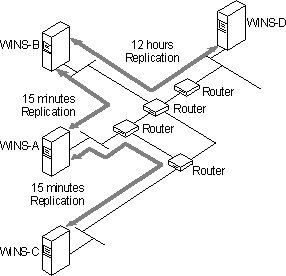
The time needed to replicate a new entry in a WINS database from the WINS server that owns the entry to all other WINS servers on the network is called convergence time. When planning for WINS servers, you need to decide what is acceptable as the convergence time for your network.
This following figure illustrates an example network installation of WINS servers and the database replication interval between each WINS server. This example network configuration is presented to show how replication interval between WINS servers affects the convergence time.

Figure 8.6 Replication Intervals Between WINS Servers in a Routed TCP/IP Network
If a WINS client registers its name with the WINS server labeled WINS_C in the figure, other WINS clients can query WINS_C for this name and get the name –to-IP-address mapping. WINS clients that query any of the other WINS servers shown in the figure (WINS_A, WINS_B, and WINS_D) do not get a positive response until the entry is replicated from the WINS_C server to WINS_A, WINS_B, and WINS_D. WINS_C is configured to start replication when the push Update Count threshold is exceeded or when the pull Replication Interval expires on its WINS pull partner, WINS_A. (For this example, WINS_A is configured with a replication interval of 15 minutes.)
Only when the pull Replication Interval expires is the entry replicated, but queries for the new name to WINS servers B and D may still not be successful. The time interval for replication to server B is 15 minutes; to server D, it is 12 hours. The convergence time is calculated as:
Name query requests may, in reality, succeed before the convergence time has passed. This would happen if the entries have to be replicated over a shorter path than the worst case path. And it would also happen when an Update Count threshold would be passed before the Replication Interval would expire; this would result in earlier replication of the new entry. The longer the replication path, the longer the convergence time.